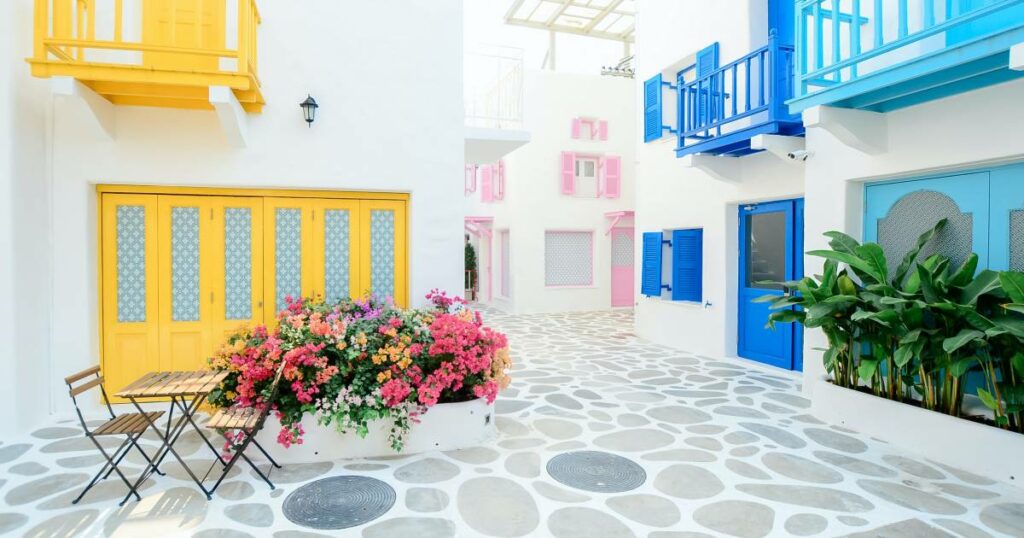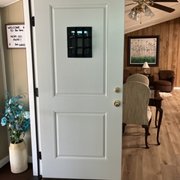A home’s exterior is the first impression for anyone who visits or just passes by. Investing in a well-designed exterior adds value to your property. From boosting the resale to creating a welcoming atmosphere, a visually pleasing and functional exterior is just important as your living interior.
Whether you’re a homeowner looking to sell or simply seeking a refreshing makeover, this article aims to be your go-to resource. We will cover everything from setting a budget, selecting the perfect color scheme, choosing building materials, and planning landscaping.
The Importance of Curb Appeal
A well-designed exterior significantly influences the monetary value of your home. Real estate professionals often point out that a strong curb appeal can increase a property’s market value by 5% to 20%. Prospective buyers usually form their initial judgments upon seeing the exterior. An attractive and well-maintained facade suggests that the interior and other aspects of the home are equally well-kept, making it more appealing to buyers. For homeowners considering selling their property, enhancing the curb appeal can provide a lucrative return on investment.
The advantages of an aesthetically pleasing exterior extend beyond financial gains. A well-designed exterior serves as a source of emotional well-being. Coming home to a beautiful and welcoming space can elevate your mood and instill a sense of pride. A well-kept front yard, attractive lighting, and an inviting entryway can be the backdrop for family events, social gatherings, or solitary moments of peace. This enriches your daily living experience and fosters a sense of community and personal contentment.
Setting a Budget

Budget planning serves as the backbone of any successful exterior redesign project. Without a well-defined budget, you risk overspending or, conversely, cutting corners that could diminish the quality and longevity of the renovation. A budget acts as a roadmap, guiding you through the maze of choices in materials, design elements, and labor costs. Therefore, having a financial plan helps keep your project on track and ensures that you make informed decisions that balance quality and cost.
To allocate your budget wisely, start by breaking the overall project into individual elements such as painting, landscaping, lighting, and exterior additions like a porch or deck. Assign each aspect a percentage of your total budget based on their importance and complexity. For example, you might allocate 30% to landscaping, 25% to new siding or painting, 15% to lighting, 10% to an entryway revamp, and the remaining 20% to additional features and contingency. Always include a contingency fund of around 10% to handle unexpected expenses like repairs or permit fees. By segmenting your budget, you create a financial framework that allows creativity and discipline.
Evaluating the Current Exterior
A comprehensive inspection and assessment are necessary before embarking on the journey of redesigning your home’s exterior. This step serves two primary functions: It allows you to take stock of what you already have, and it aids in identifying areas that require change or improvement. A thorough assessment should include examining the current paint or siding condition, the state of the windows and doors, the lighting quality, and the landscaping elements’ health. You should also evaluate the structural integrity of any existing exterior features like decks, patios, or fencing.
Once the inspection is complete, you can identify what needs to be changed, updated, or replaced. Make a detailed list segregating items that require immediate attention from those that can wait. For example, deteriorating siding or a crumbling driveway could be prioritized over cosmetic upgrades like new outdoor furniture or decorative elements. Separating “needs” from “wants” in this way helps you allocate your budget more effectively and keeps the focus on critical renovations that will impact both the aesthetic and functional aspects of your home’s exterior.
Trending Exterior Design Styles
Modern: Modern exterior designs are marked by clean lines, minimalistic features, and a focus on function. Materials like glass and metal are often used to create an edgy, contemporary look.
Traditional: Traditional styles often incorporate elements like brick facades, gabled roofs, and classic color schemes. These designs aim to create a timeless appeal that often draws from regional or historical aesthetics.
Vintage: Vintage exteriors bring back styles from specific eras, be it the ornate features of Victorian homes or the functional simplicity of mid-century designs. The goal is often to recreate a nostalgic atmosphere while integrating modern conveniences.
Customized Hybrid Styles: Hybrid styles blend various design elements, taking inspiration from traditional and modern aesthetics. These styles allow homeowners to create a unique exterior that reflects their tastes.
Color Schemes

Palette Trends: Current trends in exterior color schemes lean towards neutral tones with bold accents. Think of greys, whites, or beiges offset by vibrant front doors or shutters in blues or reds.
Coordination with Existing Elements: When choosing colors, it’s wise to consider existing elements like roofing, stonework, or landscaping. Coordinating these can create a harmonious and well-balanced exterior.
Seasonal Impact on Color Choices: Different seasons can influence how a color appears due to changes in natural light. For example, a warm and inviting color in summer may look dull in winter. It’s beneficial to think seasonally when making your color choices.
Building Materials
Traditional (Wood, Brick): Wood and brick are time-tested materials that offer a warm, natural aesthetic. While they can be more labor-intensive to maintain, their timeless appeal is often worth the effort.
Modern (Vinyl, Metal): Materials like vinyl siding and metal are becoming increasingly popular for those looking for lower maintenance and a contemporary look. These options offer durability and come in a variety of colors and textures.
Sustainable Options: Environmentally friendly materials like recycled metal, composite wood, and eco-friendly paints are gaining traction. These options not only reduce your ecological footprint but can also offer long-term cost benefits.
Exterior Additions

Porches and Decks: Adding a porch or deck can significantly increase your living space and provide a platform for outdoor activities. These structures are both functional and can enhance the visual appeal of your home.
Outdoor Kitchens: For those who enjoy al fresco dining or entertaining, an outdoor kitchen can be an exceptional addition. These spaces often become focal points for social gatherings and can add a touch of luxury to your exterior.
Garden Spaces: Gardens offer both aesthetic and emotional benefits. Whether a vegetable patch or a flower garden, these spaces provide a personal retreat and elevate the home’s visual appeal.
Fences and Gates: Fences and gates offer privacy and security and serve as decorative elements. The design and material should harmonize with the overall exterior design for a cohesive look.
Landscaping
Lawn Maintenance: A well-kept lawn is the canvas for your home’s exterior. Regular mowing, fertilizing, and weed control are necessary to keep it lush and inviting.
Flowerbeds and Shrubbery: Incorporating flowerbeds and shrubs adds layers and textures to your outdoor space. Choose plants that thrive in your local climate to ensure they remain vibrant and healthy.
Hardscaping Options: Beyond plants, hardscaping elements like pathways, patios, and retaining walls contribute to the functionality and aesthetics of your exterior. These can be crafted from materials like stone, concrete, or brick.
Lighting

Safety Features: Adequate exterior lighting is a key element for ensuring safety. Well-lit pathways, entrances, and outdoor areas deter intruders and prevent accidents, making it an aspect that shouldn’t be overlooked.
Aesthetic Impact: Beyond safety, lighting also significantly highlights your home’s architectural and landscaping features. Subtle spotlights, fairy lights, or lanterns can dramatically change the ambiance of your exterior.
Types of Lighting Fixtures: The market offers a variety of lighting options, ranging from traditional lanterns to modern LED fixtures. Your choice should align with the overall design theme of your exterior for a cohesive look
Entryway Revamp
Doors: The front door often serves as the focal point of a home’s exterior. Updating it can provide both a style boost and improved security. Options range from traditional wooden doors to modern options with glass panels or intricate designs.
Welcome Mats: A simple yet effective way to add character to your entryway is through a welcome mat. This functional décor item can match the home’s exterior palette or offer a pop of contrast.
Statement Pieces: Adding statement pieces like decorative planters, sculptures, or even a unique mailbox can elevate the entire entryway. These elements provide an opportunity for personal expression while enhancing the visual intrigue of the home’s exterior.
Legal and Zoning Considerations
Before initiating any significant exterior changes to your home, it’s imperative to consult local zoning laws and neighborhood guidelines to ensure your plans are compliant. Failure to do so can result in legal complications, fines, or even the necessity to undo completed work. Obtaining any required permits or approvals is equally important, as these documents often stipulate what can and cannot be done. Compliance with these rules safeguards your project and your relationship with your community.
Maintenance

Long-term Care of New Exterior Elements: Once your home’s exterior has been redesigned, maintaining its new features is key to preserving its quality and appearance. Whether repainting the siding every few years or sealing a wooden deck, each element has its own maintenance requirements that must be routinely addressed.
Routine Check-up and Repair: Regular inspections can help catch minor issues before they become major problems. For instance, checking for loose fence panels or damaged roof shingles enables timely repairs, preventing more extensive damage and costs in the long run.
The Last Brushstroke: Sealing Your Exterior Makeover Vision
In this transformative journey of home improvement, consider the exterior of your house as the cover of your life’s ever-evolving story. The impact of a well-designed exterior transcends beyond mere aesthetics—it influences your home’s market value and contributes to your emotional well-being. As you digest this guide’s insights and ideas, let them catalyze turning your dream exterior into a tangible reality. No step is too small; every effort counts towards creating a more beautiful, functional, and inviting home. So why wait? It’s time to act and redefine how your home interacts with the world.



























